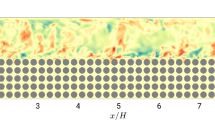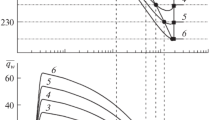Abstract
The well-known fact of intensification of heat transfer in strongly accelerated flows because of destruction of the viscous sublayer by substance injected through a porous surface is analyzed experimentally.
Similar content being viewed by others
Literature cited
A. F. Orlando, R. J. Moffat, and W. M. Kays, “Turbulent transport of heat and momentum in a boundary layer subject to deceleration, suction, and variable wall temperature,” Report HMT-17, Stanford University (1974).
A. I. Leont'ev et al., “Investigation of the fluctuating structure of the thermal turbulent boundary layer under flow laminarization conditions,” Heat and Mass Transfer-VI [in Russian], Vol. 1, Pt. 2, Minsk (1980), pp. 136–146.
V. P. Zabolotskii, P. S. Roganov, and E. V. Shishov, “Experimental apparatus and results of investigating the characteristics of an accelerated, turbulent boundary layer with injection,” Trudy MLTI, No. 138, 72–81 (1981).
Author information
Authors and Affiliations
Additional information
Translated from Inzhenerno-Fizicheskii Zhurnal, Vol. 47, No. 3, pp. 388–392, September, 1984.
Rights and permissions
About this article
Cite this article
Roganov, P.S., Zabolotskii, V.P. Features of turbulent heat transfer on permeable surfaces. Journal of Engineering Physics 47, 1027–1030 (1984). https://doi.org/10.1007/BF00873712
Received:
Issue Date:
DOI: https://doi.org/10.1007/BF00873712




